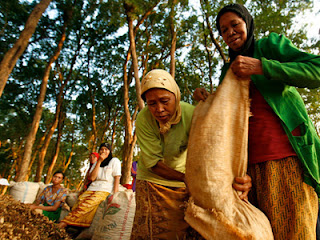Laadli Celebrates the Power of
Swathi Chaganty
“I regard the theatre as the greatest of all art forms, the
most immediate way in which a human being can share with another the sense of
what it is to be a human being.” ― Oscar Wilde
This could not be further from
the truth for us at Population First, for arts and theatre are some of the core
tools of our outreach. Be it street plays in collaboration with Theatre of
Relevance or college productions across the city of Mumbai on gender-based
issues, school plays on sanitation in Shahapur Zilla Parishads or theatre
workshops for our village level committees and health service providers in the
past, have deeply affected the audience and the participants alike. For some,
the plays left an indelible mark on the current state of affairs in the society
while for some the art of acting and theatre as a tool helped understand their
own role in the society and its development.
So, it was only logical
progression for us to honour the art form itself in our Laadli Media and
Advertising Awards for Gender Sensitivity (LMAAGS).
And as the world celebrates this
art form today, we thought of taking a trip down the memory lane, when Theatre
became one of our major categories at the National LMAAGS.
2016-2017
Saat Teri Ekvees
 In its 3rd season,
Saat Teri Ekvees, a Manhar Gadhia Productions, has a new set of monlogues by
women and has an underlying theme of “desire”. It explores narratives on
Survival, Intimacy, Being Oneself, Motherhood, Love, To Be Born and
Appreciation. Some stories evoke heart-warming smiles, others evoke a
soul-searching silence but all makes one sit-up and notice a woman’s soul and
situations. The play deals with women characters that have shown strength and
courage to establish their individuality in an unsupportive social structure.
In its 3rd season,
Saat Teri Ekvees, a Manhar Gadhia Productions, has a new set of monlogues by
women and has an underlying theme of “desire”. It explores narratives on
Survival, Intimacy, Being Oneself, Motherhood, Love, To Be Born and
Appreciation. Some stories evoke heart-warming smiles, others evoke a
soul-searching silence but all makes one sit-up and notice a woman’s soul and
situations. The play deals with women characters that have shown strength and
courage to establish their individuality in an unsupportive social structure.
2015-2016
Shinkhandi – The Story of the
In-Betweens
A comic, tongue-in-cheek,
re-telling of the story of Shinkhandi; mixing the traditional with the
contemporary, the grandeur of physical Indian storytelling and contemporary
English verse – questioning gender, sexuality, masculinity, femininity, and
everything in between. This unique perspective and the conversational style of
the play motivates the audience to examine their own biases and realise the futility
of the labels that society enforces.
2014-2015
Ila by The Patchworks Ensemble
Directed by Puja Sarup and Sheena
Khalid, ‘Ila’, looks at gender, its related myths as well as the dilemmas and
the importance they play in our lives today. The story is about a king who
ventures into an enchanted forest and is transformed by a spell. As the moon
waxes and wanes so does Ila, turning from man to woman and back to man. With
ever-changing landscapes sometimes in ancient land and sometimes in the local
trains of Mumbai- and leaps in time, his chorus takes the audience through a
provocative, playful and exciting journey that questions what it means to “be a
women/man and everything in between.”
Jug Jug Jiyo
An innovative play in Hinglish,
Jug Jug Jiyo, directed by Smita Bharti, unravels the lives of two women across
three decades, who are sharing a house in a small town. The play begins with
the visit of their children who are in a live-in-relationship in Mumbai to
their home town to meet their parents. The new dynamic in the family leads to a
small confrontation and lays bare the hidden past of the two women until there
is nothing left to lay bare. The story intimately journeys through hard hitting
topics of social stigma of unmarried and pregnant women, marital rape, female
foeticide, infanticide, trafficking and illegal surrogacy. Jug Jug Jiyo is an
entertaining yet socially relevant play that compels one to think of the many
messages it wants to deliver. It ends with love and hope that change is possible.
2012-2013
Baaware Maan Ke Sapne
An all women production, ‘Baaware
Maan Ke Sapne’ enacted by homemakers who have gone through vigorous training of
discipline of time, space and body, besides sessions on acting, communication
etc. The protagonist Amma, an elderly woman decides to visit her daughter in
London, and in her preparation for the voyage gets together with all the women
in her family who share their stories – each being ruthless commentary on
social evils that plague us to this day. The play intelligently wove excerpts
from various stories by Indian women writers like Jhumpa Lahiri, Lalitambika
Antarjanam, dealing with tradition and scepticism, collective responsibility
and individual choice, into its narrative.
2011-2012
OK Tata Bye, bye
Based on the Bachchda women who,
by tradition, are sex workers and bread winners in their family, OK Tata Bye,
bye, is a poignant play on a community that follows the matrilineal system. The
play is based on filmmakers trying to capture the lives of the community on
camera but they soon realize that these girls maybe naïve but not fools and it
is the filmmakers who are the ones facing some hard questions.
“Great theatre is about challenging how we think and
encouraging us to fantasize about a world we aspire to.” – Willem Dafoe







